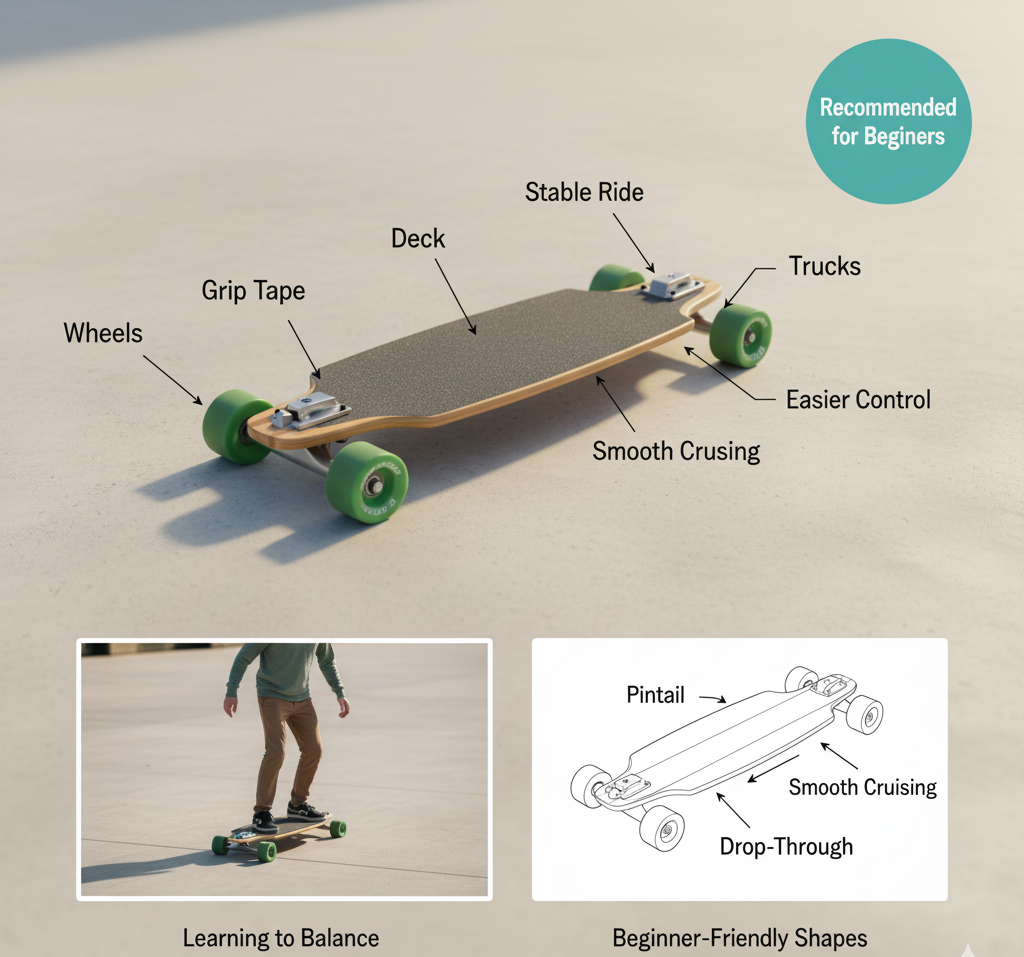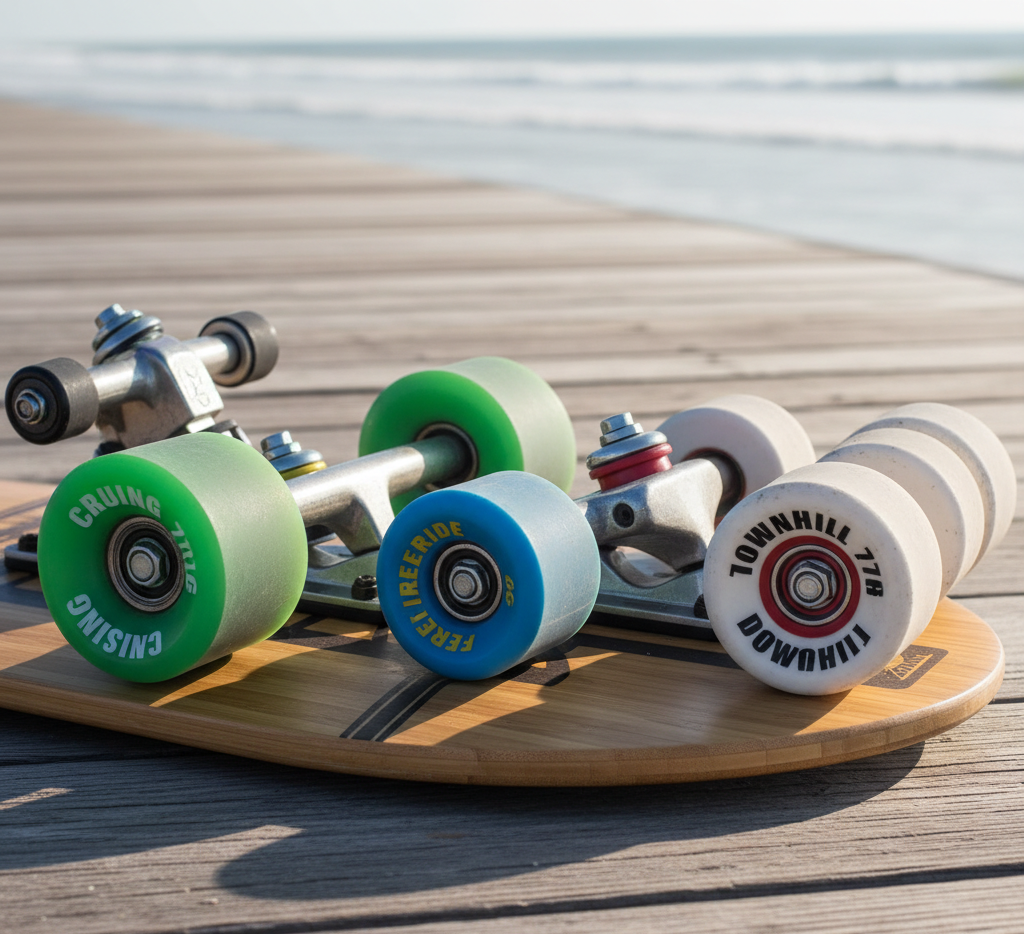For anyone new to longboarding, the first question is often the most confusing: Which longboard should I buy?
With so many shapes, sizes, and setups out there — from pintails and drop-throughs to twin-tips and cruisers — it’s easy to feel overwhelmed. The truth is, choosing the best longboard for beginners comes down to understanding a few essential factors: board shape, deck size, wheel type, and your riding style.
This comprehensive guide will help you make an informed choice so you can start riding confidently, safely, and with style. Whether you dream of cruising down boardwalks, carving suburban streets, or commuting through your city, the right beginner longboard can make all the difference between frustration and pure joy.

- Why Longboarding Is Ideal for Beginners
Before diving into specifics, it’s worth knowing why longboards are often better for newcomers than traditional skateboards.
Unlike skateboards, which are designed for tricks and park riding, longboards are longer, wider, and more stable. Their shape allows for better balance and smoother rides, even on rough pavement.
Benefits for Beginners:
- Stability: Longer decks provide a stable base, reducing the chance of wobbling or falling.
- Smooth Ride: Softer and larger wheels absorb cracks, bumps, and debris.
- Easier Control: Wider trucks and flexible decks make learning turns easier.
- Comfortable for Cruising: Perfect for relaxed rides rather than tricks.
According to Warehouse Skateboards, the average longboard length (around 38–42 inches) offers the best balance for beginners — not too long to control, but stable enough to inspire confidence.
Think of a longboard as your training ground for balance, coordination, and road feel — everything you need to become a confident skater.
- Understanding the Anatomy of a Longboard
To find the best longboard for beginners, it helps to understand what makes up the board itself. Each part influences how the longboard rides and feels underfoot.
- The Deck
The deck is the platform you stand on. Its shape, length, and flexibility determine the board’s comfort and stability.
- Length: Most beginner boards fall between 38”–42”.
- Width: Wider decks (9”–10”) offer more foot space and balance.
- Flex: Softer flex gives smoother rides but less stability at high speed.
- The Trucks
These are the metal components connecting wheels to the deck. Beginners benefit from reverse kingpin trucks (RKP), which provide smoother, more responsive turning.
- The Wheels
Larger, softer wheels (70–75mm, 78A–82A) are perfect for beginners. They roll easily over rough terrain and grip well on turns.
- The Bearings
High-quality bearings reduce friction and make rides smoother — look for ABEC ratings 5 and above.
When choosing your first longboard, look for a board with a balanced combination of these parts — not the cheapest, but one designed for comfort and control.
- Best Longboard Shapes for Beginners
Longboards come in many shapes, but not all are beginner-friendly. Here are the top options for those just starting out:
- Pintail Longboards
Pintails are the classic beginner choice — simple, stable, and smooth. Their teardrop shape prevents wheel bite and makes cruising intuitive.
- Ideal for: Flat roads, gentle carving, casual riding.
- Example: Landyachtz Bamboo Pinner — combines bamboo flex with long, stable geometry.
- Drop-Through Longboards
The deck sits lower to the ground because trucks are mounted through cutouts. This reduces the center of gravity for enhanced balance.
- Ideal for: Beginners who want stability and easy pushing.
- Example: Loaded Dervish Sama — a bamboo-fiberglass hybrid perfect for learning smooth carving.

- Cruiser Longboards
Smaller than pintails, cruisers are perfect for short commutes and quick turns.
- Ideal for: Urban riding, school commutes, or short distances.
- Example: Sector 9 Lookout — compact and agile with soft, grippy wheels.
- Drop-Down Longboards
These feature a deck that drops between the trucks, offering unmatched stability for downhill or high-speed cruising.
- Ideal for: Riders who value a very low, secure stance.
- Example: Magneto Hana Drop-Down Cruiser — forgiving flex, perfect for first-timers learning control.
Pintail and drop-through longboards remain the most popular starting points because they’re easy to learn and forgiving on mistakes.
- Finding the Right Longboard Size
Deck size determines how a longboard behaves under your feet. Use this longboard size guide as a reference:
| Rider Height | Recommended Deck Length | Best For |
| Under 5’4” | 34”–38” | Compact control, light cruising |
| 5’4”–6’0” | 38”–42” | General all-purpose riding |
| Over 6’0” | 42”–46” | Maximum stability, smoother turns |
A longer deck equals more stability, while a shorter deck gives more maneuverability. For most beginners, 38–42 inches hits the sweet spot — stable yet responsive.
Tip:
If you’re unsure, start slightly longer. It’s easier to control a stable board than a twitchy one.

- Best Longboard Materials for Beginners
The material affects weight, flex, and durability.
- Maple
- Very strong and rigid.
- Best for heavier riders or those who want less flex.
- Slightly heavier but durable.
- Bamboo
- Lightweight and flexible.
- Great for beginners who want a smoother ride.
- Eco-friendly and visually appealing.
- Hybrid (Bamboo + Fiberglass or Maple)
- Offers the perfect blend of strength and flexibility.
- Recommended for versatile riders who plan to progress quickly.
Bamboo and hybrid decks are currently the most popular beginner options due to their forgiving nature and responsive feel (Loaded Boards).
- Wheel Setup: The Key to Smooth Learning
When learning to ride, wheel setup makes a huge difference. The right wheels absorb cracks and vibrations, giving a smoother, more controlled ride.
Wheel Size
For beginners, 70–75mm is ideal. Larger wheels roll easily over obstacles but accelerate slowly — perfect for balance and control.
Wheel Hardness
Soft wheels (durometer 78A–82A) grip better and reduce vibration. Harder wheels (above 85A) are faster but less forgiving.
Contact Patch
A wider contact patch offers more grip, preventing slips during learning.
Example: Orangatang 4President 70mm Wheels are highly recommended for new riders due to their soft grip and smooth roll.

- Riding Style: Choose Your Path
Choosing the best longboard for beginners depends largely on what you want to do.
- Cruising
If your goal is relaxed rides or daily commutes, go for a pintail or drop-through with soft wheels.
- Recommended boards: Landyachtz Dinghy or Magneto Cruiser.
- Carving
For smooth turns and surfing-like movement, choose a flexible bamboo deck with mid-sized wheels (70mm).
- Recommended boards: Loaded Icarus or Arbor Axis.
- Commuting
Lightweight cruisers or drop-throughs are best for pushing through city streets.
- Recommended boards: Sector 9 Meridian or Globe Geminon.
- Downhill Beginners
If you’re adventurous, pick a drop-down board for extra stability and control.
- Recommended boards: Rayne Demonseed or Atom Drop-Deck 41”.
- Safety Gear: Non-Negotiable for Beginners
Even the best longboard for beginners can’t protect you from falls — but good gear can.
Must-Have Equipment:
- Helmet: Certified skate or cycling helmets protect your head.
- Knee & Elbow Pads: Prevent scrapes and joint injuries.
- Gloves: Help with stability and hand protection during slides.
- Shoes: Flat-soled sneakers with grip (like Vans or DC).
As per SkateHut’s beginner guide, consistent use of protective gear reduces injury risk by more than 80% during early learning stages.
- Maintenance Tips for Your First Longboard
Keeping your board in shape ensures a safer, smoother ride.
Simple Routine:
- Clean bearings regularly with bearing cleaner or alcohol.
- Check wheel wear and rotate if edges become uneven.
- Tighten trucks slightly if you experience speed wobble.
- Wipe down the deck to remove dirt and water.
A little maintenance extends the life of your setup — and keeps every ride consistent.
- Top Recommendations: Best Longboards for Beginners (2025)
Here are a few trusted options that consistently perform well for new riders:
| Model | Type | Ideal For | Highlights |
| Landyachtz Drop Cat 38” | Drop-through | All-around stability | Low deck, smooth flex, soft wheels |
| Loaded Dervish Sama | Drop-through | Carving & cruising | Bamboo-fiberglass flex, responsive feel |
| Magneto Bamboo Cruiser | Pintail | Everyday rides | Lightweight, eco-friendly, stylish |
| Sector 9 Aperture | Drop-through | Urban riding | Grippy wheels, easy turns |
| Atom Drop-Deck 41” | Drop-down | Beginner downhill | Extremely stable, affordable |
All of these boards strike the perfect balance between ease of use, durability, and versatility. They’re built for riders who want to learn comfortably while improving their skills.
- Common Beginner Mistakes to Avoid
Even with the best longboard for beginners, mistakes happen. Here’s how to avoid the most common ones:
- Choosing a board too short — shorter decks feel unstable.
- Skipping safety gear — helmets are essential.
- Overtightening trucks — restricts turning and balance.
- Riding downhill too soon — start on flat surfaces first.
- Ignoring wheel maintenance — dirt buildup affects ride smoothness.
Every experienced rider was once a beginner. The difference is patience and consistent practice.
- Tips to Build Confidence as a Beginner
Learning to longboard can be intimidating, but it becomes second nature with time.
- Start on a smooth, flat surface like a parking lot or quiet road.
- Practice balancing stationary before pushing.
- Gradually learn carving turns to improve control.
- Ride at your own pace — don’t rush downhill or tricks.
- Watch tutorials from reliable skate schools or YouTube instructors.
The key is consistency — a few minutes of daily practice can turn a wobbly start into confident cruising within weeks.
- How to Progress After Your First Longboard
Once you’ve mastered pushing, turning, and braking, you can start exploring new longboard disciplines.
- Freestyle
Learn footwork, pivots, and balance tricks. Choose a twin-tip deck for more freedom.
- Dancing
Use longer decks (45–48”) with medium flex. Perfect for rhythm-based movement and expression.
- Downhill
Upgrade to stiffer boards and harder wheels for speed control and stability.
Each style opens a new world of skills and creativity — and your beginner board can often adapt as you improve.
- Why Beginner Longboards Matter More Than You Think
Your first longboard isn’t just a piece of gear — it’s your gateway into a lifestyle. The right board helps you learn balance, control, and connection with your environment.
A bad board can cause frustration and slow progress, while a well-designed beginner longboard makes every push rewarding.
That’s why focusing on comfort, control, and quality components is so important for newcomers.
As Stoked Ride Shop points out, beginners should choose boards that build confidence, not just speed — comfort leads to skill, and skill leads to mastery.
- Final Thoughts: Choosing the Best Longboard for Beginners
The best longboard for beginners is one that matches your comfort level, height, and riding goals. Stability should come before speed, and flex before rigidity.
To summarize:
- Deck: Go for 38–42 inches long.
- Shape: Choose pintail or drop-through for stability.
- Material: Bamboo or hybrid for flex and durability.
- Wheels: 70–75mm, soft (78A–82A).
- Trucks: Reverse kingpin for smooth turning.
Start simple, stay safe, and focus on mastering the basics. With time, you’ll find your rhythm — carving, cruising, and gliding effortlessly through the streets.
Longboarding isn’t about speed; it’s about flow, balance, and freedom.
And the right beginner board will take you there.

